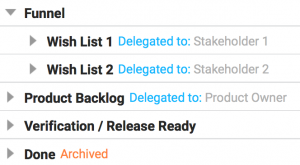Blog
May 18, 2018
What Is Product Backlog Grooming?
Product backlog grooming, also called product backlog refinement or backlog management, is an ongoing process in Agile development, in which the product owner and relevant stakeholders make sure that:
- The product backlog has the right items.
- The backlog items are prioritized.
- High-priority items are ready to be committed to a sprint (by adding the right detail to them).
 Back to top
Back to top
Why is Backlog Grooming Important?
Regular grooming is absolutely essential. It ensures a relevant connection between what the market expects from your product and what your organization actually plans to deliver. It helps make sure that the team is completing the most important work, which improves both team motivation (“My work is important!”) and the long-term sustainability of the business.
The process of refining the backlog is mostly managed by the product owner (in an Agile Scrum environment), who owns the backlog with the assistance of relevant stakeholders. These stakeholders may include: business executives, the development team, and others, such as the scrum master.
Back to top
How do You Perform Product Backlog Grooming — Best Practices
Backlog grooming is an ongoing process. But it’s common practice to hold meetings with relevant stakeholders on a regular cadence (every second week, for example). During these meetings, the product owner, in coordination with others, will look at existing user stories and remove those that are no longer relevant. They may add user stories, split large user stories, or change priority of existing user stories. They also may include or adjust estimates for user stories.
Whatever you do, make sure it’s D.E.E.P.!
A DEEP backlog is one that is:
Detailed Appropriately, Estimated, Emergent, Prioritized
Building a D.E.E.P. Backlog
The acronym D.E.E.P., coined by long-time Agile advocate Roman Pichler, is commonly used to describe the ideal, well-managed backlog.
Detailed Appropriately — Upcoming, high-priority backlog items should have more detail than distant, low-priority items. This prevents waste (and confusion) that results from spending too much time breaking down backlog items that are irrelevant to an upcoming sprint. It also ensures the development team has all the detail they need to successfully complete the items in their next sprint.
Estimated — Most backlog items should be estimated. Common estimates are story points, hours, even T-shirt sizes (small, medium, large, x-large). By estimating backlog items, we have an understanding of the cost to implement them, which is must-have information for prioritization. (We want to extract maximize value from a minimal amount of work). Estimating also offers a point of comparison. You can check your estimate against the actual, thereby improving future planning.
Emergent — The product backlog is a dynamic document of planned work that reflects real-time needs and priorities of the business. It should be a fast-flowing river where new ideas turn into completed work, not a swamp where idle ideas sit and slowly decay. As new discoveries are made over time, include them in the backlog or its product risks becoming obsolete.
Prioritized — What should you work on next? The backlog should have highest priority items at the top, lowest priority items at the bottom. The team that’s constantly completing their highest priority, most valuable backlog items is the team that’s delivering the most value, fastest to customers. To set the priority, one must have a deep understanding of the market (the current and future customers ultimately define what is valuable) as well as the cost to implement each item.
>>Is your backlog too big? Download 6 Tips for a Leaner Backlog <<
Back to top
3 Tips for Better Backlog Refinement Meetings
A regular backlog grooming meeting is necessary when your product has multiple stakeholders. The session is often completed in preparation for an upcoming sprint. So, for many teams, approximately every two to four weeks. It’s best to schedule the meeting a few days prior to the next sprint, since the final days are often consumed completing work in the current sprint.
At the meeting, you might:
- Write and include new user stories (if capacity allows).
- Improve or add detail to old user stories.
- Break down large backlog items.
- Estimate backlog items.
- Remove user stories that are no longer relevant. (This is often the most important aspect – and also often the most forgotten – of the meeting.)
How do you get the most out of your session?
In many ways, a good backlog grooming meeting follows the rules of any good normal meeting: only invite those who are necessary, make sure you’re prepared, and limit its length.
Don’t Invite Everyone — Let’s start with who should be present. The product owner is the only must-have at the session. Who should you leave out? Anyone without skin in the game. If there are business stakeholders you need input from, gather it ahead of time or limit their attendance to one or two members. If you need input from the development team, do it ahead of the meeting, immediately after, or again include just one or two people with the right skills.
Arrive Prepared — What are your goals? Have a solid of what you want to achieve and make sure everyone is aware of it. Do you want to start to break down the next business epic? Do you want to remove or update old items? Make sure everyone on the team understands how they can contribute to the goals, so you get the most out of your meeting.
Keep It Short — Your work is never truly done. There is always room for improvement. Naturally, a grooming meeting wants to be long. Resist it. You can’t do everything in a single meeting. Limit it to what needs to be done. If you’re meeting every two weeks, prior to the next sprint, limit it 1-2 hours maximum. If your cadence is more spread out, your refinement meeting may increase proportionally. In many cases, it’s better to spread out one long meeting into several smaller meetings. Also, as product owner, ensure the backlog is refined continuously outside of meeting time — as you get input. You do not want to have a backlog to the backlog meeting!
Back to topBacklog Grooming: Bringing It All Together
Backlog grooming is a critical process for successful Agile development organizations. A small amount of effort in making sure your backlog is detailed, estimated, emergent, and prioritized will bring substantial results to your processes and workflows, and increase the flow of value to your product and customers.
Learn about Helix Plan (formerly Hansoft), the better backlog management tool.
Try For Free in Helix Plan

